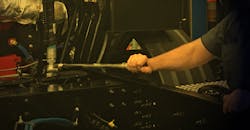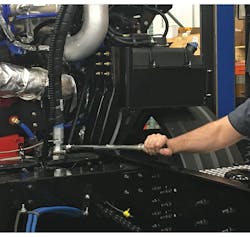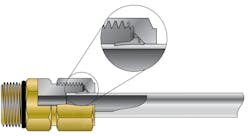Download this article in PDF format.
In front of you is an NPTF tapered-thread assembly. The recommendation is to turn, not torque, to tighten the assembly. But all you have is a torque wrench. Or maybe you have an SAE straight-thread port assembly, which has a suggested assembly torque, and your torque wrench is nowhere in sight. The inevitable question pops up: Can’t you just crank that fitting down and be done with it? Tight is tight, right?
Short answer: No. Turn refers to the number of turns you rotate the fitting to make a tight connection. Torque refers to how much torque you apply to make a tight connection. The difference may seem trivial, but it isn’t.
Torque wrenches are necessary to prevent leaks from most—but not all—hydraulic fittings. Do you know when a torque wrench should not be used?
In the case of torque, we use a calculation to determine how much torque hydraulic threads can handle without being damaged. Going greater or less than the recommended torque can lead to leaks. This likely makes sense if you don’t apply high-enough torque—it’s pretty obvious that a loose fitting will leak. But it can also leak if you apply too high a torque.
When you tighten a fitting, in some circumstances you’re actually deforming the metal. That can damage threads and sometimes the fitting, making it unfit for reuse. In other circumstances, an O-ring could be pushed down into the female threads, compromising the seal of the connection. Additionally, if that O-ring is old or dry, it can crack under excessive pressure, leaving you without a proper seal and, again, the possibility of leaks. The same holds true for the methods requiring turning the fitting. So even if you think you’re an assembly master, when you tighten based merely on your sense of what feels right, you have most likely over-tightened your fitting.
Turning and Torque: Which is Which?
When a turning method is recommended, you should see a low number in the tightening recommendations. Generally, that number will be no higher than three. The number is linked to two types of turning methods not requiring a torque wrench:
- TFFT (turns from finger tight) is the number of full rotations of the fitting recommended after you have made the connection finger tight.
- FFWR (flats from wrench resistance), sometimes called the flats method, is the recommended number of flats on the fitting’s nut that should pass a certain point after resistance is felt.
Torque is measured as force applied at a rotational radius. In the case of hydraulic fittings, it’s the rotational force used when tightening, generally with a torque wrench. The recommended torque value is a measurement of the maximum amount of rotational force necessary to ensure your fitting is tightened properly. Torque is usually measured in pound-feet or Newton-meter. Torque is important because it helps you know how tight your fitting connection needs to be when the system runs at higher pressures.
Match the Method to the Design
So when do you use these different methods? Here are some guidelines.
Tapered-thread fittings: Turn—Due to the shape of tapered-thread fittings, it’s particularly important that they never be over-tightened. More than any other fitting, they are prone to damage due to over-tightening. Damaged threads or even a cracked port end can lead to leaks and make reuse impossible. That’s why TFFT, rather than torque, is recommended for tapered-thread assembly.
An important consideration when making an assembly with a shaped fitting (such as an elbow) that has a tube end connection is to ensure you achieve proper alignment. Never back-off (loosen) tapered-thread connectors to achieve alignment.
Tapered-thread fittings should not be used because of their tendency to leak.
JIC (Joint Industry Council) 37° flare fittings: Turn—Assembling this fitting results in a metal-to-metal seal made by the cone on the female adapter or tube flare seating onto the 37° flare on a male adapter. This metal-on-metal contact can deform the fitting’s nose over time and threaten reusability. If over-tightened, the problem can be compounded. That’s why FFWR is recommended in this assembly.
JIC 37º flare fittings provide a metal-to-metal seal. Consequently, proper tightening is essential to maintain leak-free performance.
An important tip for this method: When you’ve reached the first point of resistance to your wrench, use permanent ink marker to make a longitudinal mark on one of the flats of the nut and continue it on to the body hex. Then, at the properly tightened position, mark the body hex opposite the previous mark on the nut hex. These marks will serve two important functions:
1. The displaced marks serve as a quick quality-assurance check that the joint has been tightened.
2. The second mark on the body helps indicate if the fitting has loosened. Upon reassembly, the fitting should be tightened past this mark to create a seal lower on the nose.
Placing marks on a fitting reduces the chance of error when counting the number of flats turned.
All Bite-Type Fittings: Turn—FFWR is the recommended method for all bite-type fittings. That’s because rebuilds can become a factor if the fittings are over-torqued.
See our detailed bite-type fitting assembly information for step-by-step instructions.
Tightening bite-type fittings requires counting the number of flats after first encountering wrench resistance.
O-Ring Face Seal Fittings: Torque—O-ring face seal fittings can, and should, be torqued to the recommended specifications. This is because the connection seal is made by an elastomeric seal against metal. The lack of metal-on-metal contact means that only the O-ring is being deformed in assembly and reassembly. This sealing method is very forgiving and, when assembled to the recommended torque specifications, will create a leak-free seal every time.
When tightened to the recommended torque, O-ring face seal fittings provide a reliable leak-free connection.
Straight Port Threads: Torque—All straight-thread port types should be torqued to the recommended specifications. Much like O-ring face seal ports, the O-ring used with straight thread ports is what makes the seal. Over-tightening can damage the fitting or the seal.
That said, you should take care to tighten only to the recommended torque. Over-tightening can lead to damaged fittings or O-rings, cracked ports, and, most certainly, a compromised connection seal.
Understanding the difference between a torque and a turn means you’ll never be in doubt when assembling or reassembling hydraulic fitting connections in your system, keeping it leak-free for years to come (for more, see "How Many Times Can I Reassemble a Hydraulic Fitting?").
Proper torque is essential with straight-thread fittings because over-tightening can damage the O-ring, which will lead to leakage.
Rob King is Engineering Supervisor at Parker Hannifin’s Tube Fittings Div., Columbus, Ohio. For more information on hydraulic tube fittings, call (614) 279-7070, visit www.parker.com/tfd, or email [email protected]. This material, from Parker’s techConnect blog, was used with permission from Parker Tube Fittings Division. Read more industry-specific topics on hydraulic connections, fitting applications, technical tips, and industry- and standards-related information by visiting Parker’s techConnect blog at tfdtechconnect.com.
About the Author
Rob King
Engineering Supervisor
Rob King is Engineering Supervisor at Parker Hannifin’s Tube Fittings Div., Columbus, Ohio. For more information on hydraulic tube fittings, call (614) 279-7070, visit www.parker.com/tfd, or email [email protected]. Learn more about fittings and other technical topics by visiting Parker’s Motion Control & Technology blogs at blog.parker.com.

Leaders relevant to this article:








